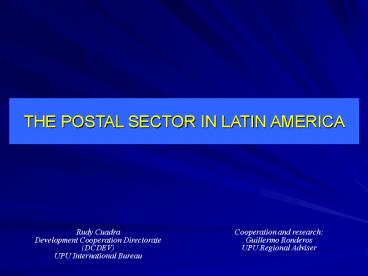Rudy Cuadra PowerPoint PPT Presentation
1 / 33
Title: Rudy Cuadra
1
THE POSTAL SECTOR IN LATIN AMERICA
Rudy Cuadra Development Cooperation Directorate
(DCDEV) UPU International Bureau
Cooperation and research Guillermo Ronderos UPU
Regional Adviser
2
General characteristics of the Latin America
region
- 19 developing countries
- 520 million inhabitants
- 20 million km2
- Huge differences between the countries of the
region
3
General postal sector characteristics
REGULATORS (7)
- 6 postal regulators attached to a Ministry
- 1 multisectoral regulator
4
General postal sector characteristics
UPS OPERATORS (19)
- 10 State Enterprises
- 4 Decentralized entities
- 4 Ministerial departments
- 1 Managed by a private operator
5 under Private Law 5 under Public Law
5
General characteristics of postal sector in Latin
America
REGIONAL LEGAL FRAMEWORK
- Outdated legislation
- Non-compliance with law (due to its weakness)
- Pressure of unregulated liberalization
- Scant regard for UPS commitments
- Few structural reform processes
6
General characteristics of postal sector in Latin
America
MARKET
- Proliferation of operators in main towns and
cities - Ignorance of the nature of demand
- Decrease in international mail flow
- Prices do not reflect quality
- Strong competition, but no sectoral investment
or development
7
The postal sector in Latin America
NATIONAL DEVELOPMENT
- Network
- Volume
SECTORAL DEVELOPMENT
- Use of services
- Causes, consequences and risks of lack of
regulation and/or hasty decisions
CONCRETE CASES
- Country case studies
8
POSTAL NETWORK DEVELOPMENT
9
MAIL VOLUME TREND PUBLIC OPERATORS
10
Growth of the Operator
11
SECTORAL DEVELOPMENT
12
MAIN REASONS FOR POSTAL SECTOR DECLINE
- Limited exercise of regulatory function
- Great regulatory weakness
- Legal framework changes not backed up by economic
or technical studies
4. National legislations do not provide for
UPS
13
MAIN REASONS FOR POSTAL SECTOR DECLINE
- Lack of investment and technology
- 6. Market disorder. Non-compliance with
legislation - 7. Opening of market without first setting
conditions - 8. Excessive fragmentation of basic services
offer
9. Incomplete reform processes
14
CONSEQUENCES
UPS OPERATORS
- Low market share. Low operational capacity
- Dearth of investment. Lack of technology
- Negative results. Resources results vicious
circle - Reform lagging behind in terms of internal
restructuring and modernization of services
15
CONSEQUENCES
POSTAL SECTOR AND CITIZENS
- THOUSANDS OF UNREGULATED COWBOY OPERATORS
OFFERING NO BENEFIT TO THE STATE - DEMAND THWARTED BY A LACK OF VIABLE SUPPLY
ALTERNATIVES - UNDESIRABILITY OF SECTORAL INVESTMENT
- CITIZENS BASIC RIGHTS ARE AFFECTED
- NO SECTORAL GROWTH OR DEVELOPMENT
16
SHORT- AND MEDIUM-TERM RISKS
- DECREASE IN UPS PROVISION
- DETERIORATION IN QUALITY OF SERVICE
- STATE CALLED ON TO SUBSIDIZE UPS PROVISION
- BANKRUPTCY OF UPS OPERATORS
- MISCONCEPTION OF THE POSTAL SECTORS TRUE SCOPE
17
6 CONCRETE CASES IN LATIN AMERICA
- A-B-C-D-E-F
- Country case studies
18
COUNTRY A
- Total liberalization of unregulated market
- Inability to define and formulate the UPS
obligation (insignificant residual service) - Failure of operational model. Liquidation of
business assets and granting of operational
rights - Lack of market knowledge. Overestimation of
demand
19
OUTCOME
DEVELOPMENT OF UPS OPERATORS POSTAL NETWORK
20
COUNTRY B
- Market totally liberalized without any form of
regulation - Regulatory body created without clear functions
or powers - 40 drop in operator volume
- The operator, obliged to provide the UPS without
compensation, has responded by reducing its UPS
provision to a minimum - Failure of business to invest or develop
21
OUTCOME
DEVELOPMENT OF UPS OPERATORS POSTAL NETWORK
22
COUNTRY C
- Market liberalization law providing for the
Operator and Regulator - Misguided market legislation due to legislators
ignorance - Sustainable financing of UPS seriously
jeopardized - Unable to compete or invest, the Operator has
lost over 70 of its market share - Government staved off the Operators bankruptcy
by standing over 25 of its costs
23
OUTCOME
DEVELOPMENT OF UPS OPERATORS POSTAL NETWORK
24
COUNTRY D
- Postal enterprise established (in 1993) without a
sectoral legislative framework. Lack of
investment. Failure of operator to modernize - Attempt at reform by privatizing the operator
- Process funded by international financial body
- Failure and discontinuation of process
- Greater decline than under the previous set-up
25
OUTCOME
DEVELOPMENT OF UPS OPERATORS POSTAL NETWORK
26
COUNTRY E
- The Government totally liberalized the market
without any form of regulation - The business, starved of investment and unable to
compete, lost market share - Empresa de Correos intervened to privatize it
- The business was liquidated, and a call for
tenders launched, which unfortunately proved
unsuccessful - The Government has been trying to restructure the
Operator
27
OUTCOME
DEVELOPMENT OF UPS OPERATORS POSTAL NETWORK
28
COUNTRY F
- Business created as a State enterprise governed
by public law - Regulation not provided for
- The business failed to grow, due to a lack of
investment and operational capacity - The Government launched an uncoordinated reform
effort - The business is greatly debilitated and faces
serious viability problems
29
OUTCOME
DEVELOPMENT OF UPS OPERATORS POSTAL NEWORK
30
OPTIONS AND ACTIONS
- COOPERATE WITH GOVERNMENTS IN SECTORAL
REFORMPROCESSES - OFFER A REAL DIMENSION TO THE UNIVERSAL POSTAL
SERVICE AS A MOTOR FOR SECTORAL DEVELOPMENT - INTEGRATED REFORM PROCESSES TAKING ACCOUNT OF
ALLFACTORS (IPDPs) - ESTABLISH A LOGICAL PROCESS INVOLVING ALL
STAKEHOLDERS
- CARRY OUT IN-DEPTH STUDIES ON UPS
- STEP UP WORK ON CALCULATING BASIC SERVICE COSTS
31
THE IPDP PROCESS
UNIVERSAL POSTAL SERVICE Defining the UPS
SECTORAL POLICY
REGULATORY REFORM Appropriate legal framework
MODERNIZATION OF OPERATOR AND SERVICES
32
IPDP
1. Preserving the UPS
Analysis of UPS provision
UNIVERSAL POSTAL SERVICE Defining the UPS
Market study
Cost Accounting Analysis of basic services
SECTORAL POLICY
UPS proposal scope conditions of service and
financing
REGULATORY REFORM Appropriate legal framework
Specification of conditions governing regulation
of the UPS Development Plan
MODERNIZATION OF OPERATOR AND SERVICES
33
MANY THANKS

